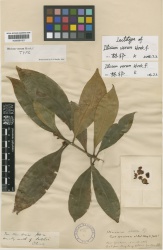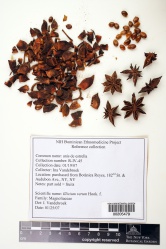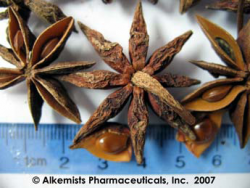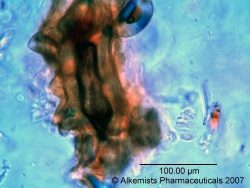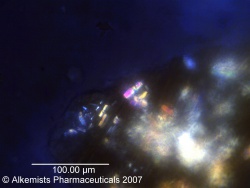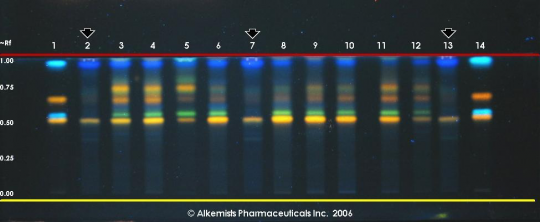Illicium verum (fruit)
Nomenclature
Illicium verum Hook. f. Illiciaceae
Standardized common name (English): star anise
Ayurvedic name(s): takkola
Botanical Voucher Specimen
 |
|
|
|
|
Organoleptic Characteristics
|
Macroscopic Characteristics
|
Microscopic Characteristics
 |
 |
|
|
|
High Performance Thin Layer Chromatographic Identification
|
Star Anise (fruit) (Illicium verum) Lane Assignments Lanes, from left to right (Track, Volume, Sample):
Reference Sample(s) Lanes 1 and 14, a 1μL of a solution of rutin (AE038, Spectrum), chlorogenic acid (03450-001), hyperoside (072605, Chromadex), and caffeic acid (NG0541, Spectrum), ~0.1% in CH3OH Stationary Phase Silica gel 60, F254, 20 x 10 cm HPTLC plates, Merck or equivalent Mobile Phase Ethyl acetate: glacial acetic acid: formic acid: water [10/1.1/1.1/2.4] Sample Preparation Method 0.5 g raw material with 5 mL CH3OH added and sonicated for 15 minutes then heated in a dry block incubator at 65° C for about 1 hr. The supernatant is used as the test solution. Detection Method (1) Natural Product Reagent + PEG, UV 365 nm (2) UV light at 254 nm Other Notes The solid yellow lines 10mm from the bottom of the place mark the sample origin. The red line marks the solvent front at 70mm. Lanes 2, 7, and 13 in the above chromatograms are from Illicium anisatum voucher specimens while lanes 3, 4, 5, 6, 8, 9, 10, 11 & 12 were made with Illicium verum. Lanes 1 and 14 are the above described reference materials. These chromatograms demonstrate a clear difference between authentic star anise (I. verum) fruit and a known adulterant, I. anisatum by the following features. The samples in lanes 2, 7, and 13 created from I. anisatum, reveal a distinctly different ‘fingerprint’ from that of I. verum in lanes 3 – 5, and 8 – 12. There are no bands or only very light bands between the yellow band at Rf ~ 0.50 corresponding to rutin and the bright blue fluorescent band at Rf ~ 0.95 corresponding to caffeic acid in the I. anisatum in image 2 above. There also appears to be no green band in any of the I. anisatum as is in the I. verum. These chromatograms clearly reveal the chromatographic differences between (Chinese) star anise (I. verum) and its adulterant, Japanese star anise (I. anisatum), and the ease with which they may be distinguished by High Performance Thin-Layer Chromatography (HPTLC). Samples in Lanes 2, 3, 4, and 5 were obtained from the American Herbal Pharmacopoeia®, Scotts Valley, CA. Alkemist Pharmaceuticals retains samples of each of these in their herbarium. Further methodology available here, in Identification method of Star Anise by HPTLC. Source: AHPA Practicals, Alkemist Labs [8] |
Supplementary Information
(Chinese) star anise (fruit) (Illicium verum)
General Characteristics AHPA recommends in its Known Adulterants list that appropriate steps be taken to assure that this raw material is free of the noted adulterant. Contact AHPA for additional information regarding relevant analytical methods or follow this link for more information.
Reported Adulterants Japanese star anise (Illicium anisatum) fruit.
Source: AHPA Known Adulterants [9]
AHPA Practical: Analytical Tools and Methods to Authenticate Star anise (fruit)
Introduction
The American Herbal Products Association (AHPA) is providing here a review of analytical tools and methods used to authenticate the identity of raw materials labeled as star anise (Illicium verum Hook. f.) fruit and for differentiating it from the fruit of toxic Illicium species including Japanese star anise (Illicium anisatum L.).
Japanese star anise has long been known to contain toxic principles and cases of poisoning have occurred from treatment of infant colic by administration of tea made from its toxic fruit instead of from the fruit of true star anise, which is also sometimes referred to as Chinese star anise. AHPA is providing this information as a technical information service to industry and not in response to any indication that there may be problems with food or supplement products containing star anise because supplements, beverage teas, and tea bags have not been implicated in reported poisoning cases.
Reports of Toxicity in Infants from Japanese Star Anise Tea
US reports of toxicity from administration of tea made from packaged spice material thought to be star anise to infants originated from the emergency room of the Miami Children’s Hospital.[10] This led to the issuance of an FDA advisory to the public not to consume "teas" brewed from star anise.[11]
The original advisory “noted that FDA’s concern that the commonly available Chinese star anise (Illicium verum), a product considered by FDA to be generally recognized as safe (GRAS), may contain Japanese star anise (Illicium anisatum). Japanese star anise has long been recognized as toxic in many countries and should be used for decorative purposes only.”
Other reports of poisoning in infants from consumption of tea brewed from “star anise” have come from France,[12] Spain,[13][14] and more recently Switzerland.[15]
Comprehensive Star Anise Review
A comprehensive review that identifies poisonous star anise (Illicium lanceolatum A. C. Smith) in addition to the highly toxic Japanese star anise (I. anisatum L.) as potential adulterants to the true (Chinese) star anise (I. verum) has recently been published. This review also summarizes the botany, traditional use, phytochemistry and toxicology of star anise, long recognized for its safe medicinal and food use.[16]
Review of Some General Methods for Authentication of Star Anise Fruit
Morphology and microscopy
Differences between whole I. verum and I. anisatum fruit are relatively minor and differentiation between them on physical characteristics is difficult and may be inconclusive when they could be present as mixtures. This is also true of microscopic characteristics where the detection of I. anisatum in powdered material by this means alone has been found to be very limited.[17] However the identity verification of Chinese star anise dried fruit when obtained as homogeneous lots from known sources can be reasonably conducted. Observable macroscopic differences in the shape of the follicles and pedicles, and the taste of the dried fruit, can allow for an appropriate identity confirmation of true star anise.
Macroscopic and organoleptic descriptions of Illicium species can be located in historical references available from http://books.google.com though the nomenclature in historical references may be misleading because I. anisatum L. was better known as I. religiosum Siebold & Zucc. and I. verum Hook f. was often referred to as I. anisatum Lour.![18][19] The confusing nomenclature regarding common and Latin names for these two species has been addressed elsewhere.[20] Macroscopic and microscopic images of I. verum fruit are available HERE.
Color test
Chemical tests can be reliable methods to distinguish the fruits of I. verum and I. anisatum, and may directly assess safety between materials if they quantify the content of the sesquiterpene lactone anisatin, which is thought to be responsible for the toxicity of I. anisatum fruit and seeds.
Chemical differences between species can also cause different results in color test reactions such as was described for star anise in 1962.[21] This test procedure distinguishes the fruits of I. verum from those of I. anisatum by employing an acid-base extraction of distilled essential oil followed by the addition of orthophosphoric acid and phloroglucinol. The light yellow color of the solution made from treatment of I. verum from will change to pink within 5-10 min, and darken upon standing, while that produced from I. anisatum remains yellow.
Fluorescent microscopy (and GC-FID)
Other researchers reported the ability to clearly differentiate I. verum from I. anisatum fruit powder, including in a 1:1 mixture, via fluorescent microscopy. This group also developed a gas chromatographic (GC) method employing a flame ionization detector (FID) that easily differentiated simple extracts of these materials, including the detection of 10% I. anisatum fruit powder in a 10:90 mixture with I. verum fruit powder, due to the presence of methoxyeugenol, eugenol, and 2,6-dimethoxy-4-allylphenol in the former and not the latter.[22]
GC-MS
Other work conducted by researchers at the Royal Botanic Gardens, Kew, United Kingdom, employed thermal desorption followed by gas chromatography with a mass spectrometry detector (GC-MS) in a method that does not require distillation of star anise essential oil prior to analysis.[23] Although various samples of eight Illicium species were tested by this method, the authors did not report results conclusively differentiating the species, instead stating that the technique “can assist with the differentiation between fruit obtained from I. verum and the more toxic I. anisatum.”
Liquid Chromatographic Methods for Authentication of Star Anise Fruit
TLC
AHPA member company PhytoLab of Germany considered published GC methods inadequate because they do not include determination of the toxic constituent anisatin. Their published report contains a differentiation of several Illicium species based on thin layer chromatography (TLC), in which I. verum can be clearly differentiated, and of which they were similarly critical. (An HPTLC method and an example of results from analysis of I. verum and I. anisatum dried fruit is available HERE.)
HPLC-MS/MS
In response, they developed and validated a fast, selective, and sensitive method that can determine low adulterations of toxic Illicium species and detect toxic sesquiterpene lactones using high-performance liquid chromatography with tandem mass spectrometry detection (HPLC-MS/MS).[24]
This technique was used to measure the anisatin content of seven Illicium species, all of which, including I. verum, were shown to contain anisatin in various amounts. However, due to the low concentration of anisatin found in I. verum dried fruit samples (up to 0.3 ppm) relative to other species, and establishing a specification of a maximum of 1 ppm for quality control product release, quantification of this constituent by the reported method can insure that a batch of star anise contains less than 0.1% of I. anisatum.
PhytoLab highly qualified reference standard anisatin is available in the US through Cerilliant® (http://www.cerilliant.com/).
DNA
Multiple genetic methods are available to both identify and quantify the presence and abundance of Illicium species in a sample. DNA sequencing and restriction fragment length polymorphism (RFLP) methods have been demonstrated by researchers at the US Department of Agriculture and the University of Mississippi’s National Center for Natural Products Research to unambiguously identify and differentiate I. verum from I. anisatum, as well as to detect mixed samples.[25] In combination with real-time PCR methods, as described in a recent paper by researchers a forensic laboratory in Japan, quantification of Illicium species in a mixture is also possible.[26]
Other Relevant Sources of Star Anise Information
AHP and EP monographs
The American Herbal Pharmacopoeia and Therapeutic Compendium has published a star anise fruit monograph that includes organoleptic, macroscopic, and microscopic descriptors; other methods of analysis including HPTLC of authenticated materials; quality control; and therapeutic information. It can be ordered through http://www.herbal-ahp.org/order_online.htm. The European Pharmacopoeia also has identity and purity tests in the star anise monograph.
Analytical Considerations Based on Material Form
Whole dried fruit
This form of star anise contains DNA, chemical, microscopic, and macroscopic information and can be subjected to all the tests previously described. If assurance is present that a lot in question is homogeneous with regard to species, a macroscopic inspection of follicles and pedicles and evaluation by taste can provide a perfectly acceptable method of identity verification of (Chinese) star anise (I. verum) dried whole fruit.
Fruit pieces, powdered fruit, possible mixtures, essential oils
Due to few differentiating macroscopic and microscopic characteristics, testing star anise fruit pieces or powder for adulteration is best accomplished via chromatographic or DNA technologies. DNA is can be particularly useful for detecting the presence of trace amounts of potentially adulterating species. The color test previously described may also be useful.
Gas chromatic analysis of the material’s essential oil can aid determination of adulteration by detecting constituents from I. anisatum that are not present in I. verum. Differentiation among several Illicium species is also possible using a TLC method. The availability of liquid chromatography tandem mass spectrometry allows for direct measurement of anisatin, the major toxic compound in I. anisatum fruit.
Any technology/methodology chosen to authenticate star anise must match the particulars of the task at hand. This can be done with a thorough knowledge of the capabilities and limitations of each technology/methodology combined with an understanding of the origin of the material, its form, and potential adulterants. Readers are encouraged to directly consult the literature for more information.
Acknowledgements
Elan and Sidney Sudberg of Alkemist Labs in Costa Mesa, CA are acknowledged for providing the macroscopic and microscopic images, and the HPLTC method and image; Danica Reynaud of AuthenTechnologies in Albany, CA for information on analysis by DNA; Matthew Creswell of Oregon’s Wild Harvest in Sandy, OR for attention to historical references; Klaus Reif of PhytoLab in Germany for their method and identification of a standard source of anisatin; and to the membership of AHPA Analytical Laboratories, and Standards committees for their review of this information.
Sources
- ↑ Royal Botanic Gardens, Kew. http://specimens.kew.org/herbarium/K000681651
- ↑ Images courtesy of the C.V. Starr Virtual Herbarium of the New York Botanical Garden http://sciweb.nybg.org/science2/VirtualHerbarium.asp
- ↑ United States Dispensatory (1918)
- ↑ United States Dispensatory (1918)
- ↑ AHPA Practicals, Alkemist Labs http://www.alkemist.com
- ↑ AHPA Practicals, Alkemist Labs http://www.alkemist.com
- ↑ AHPA Practicals, Alkemist Labs http://www.alkemist.com
- ↑ AHPA Practicals, Alkemist Labs http://www.alkemist.com
- ↑ AHPA Known Adulterants http://www.ahpa.org/
- ↑ Ize-Ludlow D, Ragone S, Bruck IS, Bernstein JN, Duchowny M, Peña BM. Neurotoxicities in infants seen with the consumption of star anise tea. Pediatrics. 2004 Nov;114(5):e653-656. (Free download at http://pediatrics.aappublications.org/content/114/5/e653.full, accessed November 11, 2011)
- ↑ http://www.fda.gov/ICECI/EnforcementActions/EnforcementStory/EnforcementStoryArchive/ucm095929.htm accessed November 11, 2011.
- ↑ Minodier P, Pommier P, Moulène E, Retornaz K, Prost N, Deharo L. Intoxication aiguë par la badiane chez le nourrisson. [Star anise poisoning in infants]. Arch Pediatr. 2003 Jul;10(7):619-921. [Article in French]
- ↑ Garzo Fernández C, Gómez Pintado P, Barrasa Blanco A, Martínez Arrieta R, Ramírez Fernández R, Ramón Rosa F; Grupo de Trabajo del Anis Estrellado. Casos de enfermedad de sintomatología neurológica asociados al consumo de anís estrellado empleado como carminativo. [Cases of neurological symptoms associated with star anise consumption used as a carminative]. [Article in Spanish] An Esp Pediatr. 2002 Oct;57(4):290-294.
- ↑ Gil Campos M, Pérez Navero JL, Ibarra De La Rosa I. Crisis convulsiva secundaria a intoxicación por anís estrellado en un lactante. [Convulsive status secondary to star anise poisoning in a neonate]. [Article in Spanish] An Esp Pediatr. 2002 Oct;57(4):366-368.
- ↑ Perret C, Tabin R, Marcoz JP, Llor J, Cheseaux JJ. Malaise du nourrisson pensez à une intoxication à l’anis étoilé. [Apparent life-threatening event in infants: think about star anise intoxication!]. [Article in French] Arch Pediatr. 2011 Jul;18(7):750-753.
- ↑ Wang GW, Hu WT, Huang BK, Qin LP. Illicium verum: a review on its botany, traditional use, chemistry and pharmacology. J Ethnopharmacol. 2011 Jun 14;136(1):10-20.
- ↑ Fritz E, Ölzant SM, Länger R. Illicium verum Hook. f. and Illicium anisatum L.: Anatomical characters and their value for differentiation. Sci Pharm. 2008;76(1):65–76. (Free download at http://www.scipharm.at/download.asp?id=230 accessed November 11, 2011).
- ↑ Culbreth, D.M.R. (1896) A Manual of Materia Medica and Pharmacology: Comprising all organic and inorganic drugs which are or have been official in the United States Pharmacopœia together with important allied species and useful synthetics, especially designed for students of pharmacy and medicine, as well as for druggists, pharmacists, and physicians. Lea Brothers & Co., Philadelphia and NY, p. 57-59.
- ↑ Maisch, J.M (1882) A Manual of Organic Materia Medica: Being a guide to materia medica of the vegetable and animal kingdoms for the use of students, druggists, pharmacists, and physicians. Henry C. Lea’s Son & Co., Philadelphia, p. 295-296.
- ↑ Small E. Confusion of common names for toxic and edible “star anise” (Illicium) species. Econ Bot. 1996;50(3):337-339.
- ↑ hang SE, Dutt MC, Tee TS. A colour test to distinguish between the fruits of Illicium verum and Illicium anisatum L. J Pharm Pharmacol. 1962 Feb;14:108-109.
- ↑ Joshi VC, Srinivas PV, Khan IA. Rapid and easy identification of Illicium verum Hook. f. and its adulterant Illicium anisatum Linn. by fluorescent microscopy and gas chromatography. J AOAC Int. 2005 May-Jun;88(3):703-706.
- ↑ Howes MJ, Kite GC, Simmonds MS. Distinguishing Chinese star anise from Japanese star anise using thermal desorption-gas chromatography-mass spectrometry. J Agric Food Chem. 2009 Jul 8;57(13):5783-5789.
- ↑ Lederer I, Schulzki G, Gross J, Steffen JP. Combination of TLC and HPLC-MS/MS methods. Approach to a rational quality control of Chinese star anise. J Agric Food Chem. 2006 Mar 22;54(6):1970-1974.
- ↑ Techen N, Pan Z, Scheffler BE, Khan IA. Detection of Illicium anisatum as adulterant of Illicium verum. Planta Med. 2009 Mar;75(4):392-395.
- ↑ Matsuyama S, Nishi K. Genus identification of toxic plant by real-time PCR. Int J Legal Med. 2011 Mar;125:211-217.
